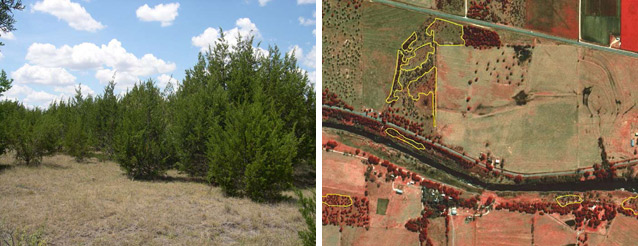The National Vegetation Classification System (NVCS)
In order to create accurate and useful vegetation maps, park managers must share a common, comprehensive system for classifying different vegetation communities. The Vegetation Mapping Program uses the National Vegetation Classification System (NVCS). This system:
- is vegetation based
- uses a systematic approach to classify a continuum
- emphasizes natural and existing vegetation
- uses a combined physiognomic-floristic hierarchy (See table below)
- identifies vegetation units based on both qualitative and quantitative data
- is appropriate for mapping at multiple scales
The use of the NVCS and the USGS-NPS vegetation mapping protocols facilitates effective resource stewardship by ensuring compatibility and widespread use of the information throughout the NPS, as well as by other federal and state agencies (Cogan and Salas 2006). The vegetation maps and associated information support a wide variety of resource assessment, park management, and planning needs. They can also be used to provide a structure for framing and answering critical scientific questions about vegetation communities and their relationship to environmental conditions and ecological processes across the landscape.
|
Table: The National Vegetation Classification Standard, version 2, with definitions and examples (FGDC 2008, Thomas et al. 2009). |
|||
|
Level |
Level Name |
Primary basis for classification |
Example |
|
Upper Level 1 |
Formation Class |
Defined by broad combinations of dominant general growth forms adapted to basic moisture, temperature, and/or substrate or aquatic conditions. |
Shrubland and grassland |
|
Upper Level 2 |
Formation subclass |
Defined by a combination of general dominant & diagnostic growth forms that reflect global macroclimatic factors driven mainly by latitude and continental position, or that reflect overriding substrate or aquatic conditions. |
Temperate and boreal shrubland and grassland |
|
Upper Level 3 |
Formation |
Defined by combinations of dominant and diagnostic growth forms that reflect global macroclimatic conditions as modified by altitude, seasonality of precipitation, substrates, and hydrologic conditions. |
Temperate grassland and shrubland |
|
Mid Level 4 |
Division |
Defined by combinations of dominant and diagnostic growth forms and a broad set of diagnostic plant taxa that reflect biogeographic differences in composition and continental differences in mesocli- mate, geology, substrates, hydrology, and disturbance regimes. |
North American Great Plains grassland and shrubland |
|
Mid Level 5 |
Macrogroup |
Defined by combinations of moderate sets of diagnostic plant species and diagnostic growth forms that reflect biogeographic differences in composition, and sub-continental to regional differences in mesoclimate, geology, substrates, hydrology, and disturbance regimes. |
Great Plains tall grassland and shrubland |
|
Mid Level 6 |
Group |
Defined by combinations of relatively narrow sets of diagnostic plant species (including dominants and co-dominants), broadly similar composition, and diagnostic growth forms that reflect bio- geographic differences in mesoclimate, geology, substrates, hy- drology, and disturbance regimes. |
Great Plains mesic tallgrass prairie |
|
Lower Level 7 |
Alliance |
Defined by characteristic range of species composition, habitat conditions, physiognomy, and diagnostic species, typically at least one of which is found in the uppermost or dominant stratum of the vegetation. They reflect regional to subregional climate, substrates, hydrology, moisture/nutrient factors, and disturbance regimes. |
Wet-mesic tallgrass prairie |
|
Lower Level 8 |
Association |
Defined on the basis of a characteristic range of species composition, diagnostic species occurrence, habitat conditions and physiognomy. They reflect topo-edaphic climate, substrates, hydrology, and disturbance regimes. |
Central wet-mesic tallgrass prairie |
Over the past twenty years, the NVCS has been developed and implemented primarily by The Nature Conservancy (TNC) and the network of State Natural Heritage Programs. It is currently maintained and updated by NatureServe. Additional support has come from federal agencies, the Federal Geographic Data Committee (FGDC), and the Ecological Society of America. In the process of applying the classification, refinements have been made and revisions suggested, leading to ongoing proposed revisions that are reviewed both locally and nationally. TNC and NatureServe have made available a two-volume publication presenting the standardized classification, providing a thorough introduction to the classification, its structure, and the list of vegetation types found across the U.S. as of April 1997. The International Classification of Ecological Communities: Terrestrial Vegetation of the United States. Volume I: The National Vegetation Classification System (Grossman et al. 1998) can be found on the Internet (at http://usnvc.org/). NatureServe has since superseded Volume II of the publication (the classification listing), providing regular updates to ecological communities in the U.S. and Canada. This online database server, NatureServe Explorer®, can also be found on the Internet (at http://www.natureserve.org/explorer).

from Cogan 2007
Part of a series of articles titled Vegetation Mapping in the American Southwest.
Last updated: July 1, 2015
